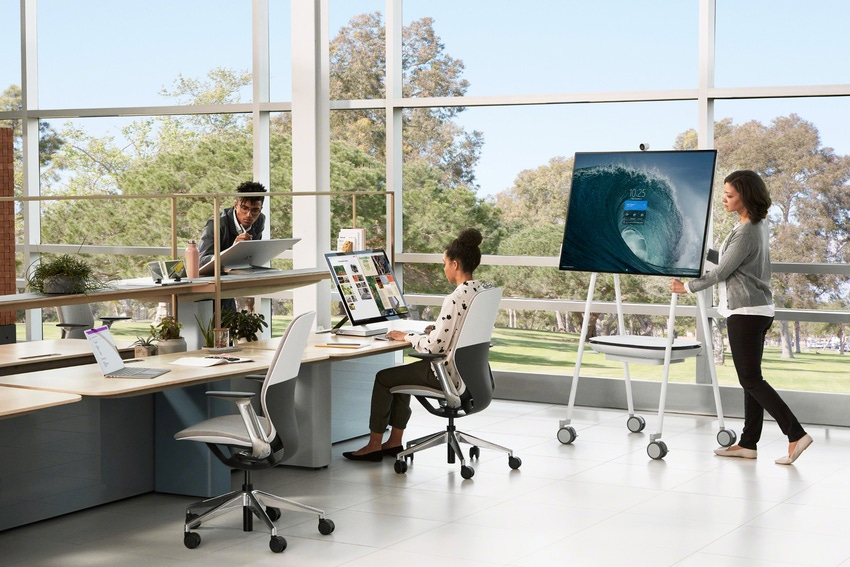Businesses large and small stand to benefit from a mix of open and controlled spaces where employees can choose how best to work.
March 4, 2020

Sponsored by Steelcase Roam
Employee experience isn’t just about pay, benefits and perks. Sure, employers can use these things to attract qualified candidates, but compensation and perks don’t always prevent people from leaving. You have to provide an environment where people like to work, collaborate and be creative–a place where they feel their contributions are valued.
Traditional workspaces–think silos, closed-doors and rows of high-wall cubes–resemble a mousetrap and were originally designed to support the hierarchy and individual tasks, not teamwork and collaboration. Today’s employees–especially workers from a younger generation–want flexible, open-air workspaces and the ability to collaborate on the fly, or see people who may be working remotely or dialing in from someplace else.
With so much emphasis on the mindset of today’s workers, businesses big and small stand to benefit from a mix of open and controlled spaces where employees can choose how best to work. Some may want to lean on a wall, perch on sofa arm or just sit on the floor. Some will look for a controlled, quiet environment in which to work heads-down, while many thrive on the idea that seats and surfaces can be moved around. One thing all generations seem to share is they want technology that helps them accomplish their tasks in collaboration with peers.
How the workspace is set up has a major impact on employee participation, productivity, satisfaction, retention and, ultimately, the company’s overall performance. Solution providers can help customers set up dynamic workspaces that encourage collaboration and creativity. There is an upsell opportunity that actually begins when solution providers talk about space.
In the course of selling technology and services, there’s no reason that solution providers can’t tell clients about how to set up collaborative spaces to enhance the employee experience. Remind them that a gratifying employee experience is always important–and ever more so when recruiting skilled employees is a big challenge and unemployment is low.
Remove the Obstacles
Step into an office, and you’re more likely to find neatly arranged cubicles or offices that cut off occupants from their teams. Team members usually come together at scheduled times in conference rooms laid out with chairs arranged around a large table and a screen somewhere on the wall.
The 2019 Steelcase Active Collaboration Study found that most organizations (70%) still use traditional conference rooms for collaborative sessions. According to 75% of respondents, meeting spaces are enclosed, and 81% of the time meetings are scheduled. But most respondents (71%) would rather meet in more open, flexible settings where they have the freedom to move around.
Adding to the problem, 73% of respondents say they don’t have access to the right people to collaborate, and 70% cannot access the information they need in real time. Visual distractions, interruptions and noise make matters even worse for 68% of respondents. Almost as many (66%) say they lack good, flexible technology to visually display work. Only 38% of workers are able to move furniture as activities change, although 54% would welcome it.
Solution providers can work with customers to overcome these obstacles by advising them on how to set up spaces and delivering office and technology solutions designed for the modern worker. For instance, Microsoft’s Surface Hub 2S is now mobile, thanks to the Roam Mobile Cart that Steelcase designed specifically for the Hub.
With the Roam, the Hub doesn’t have to be stationary, forcing people to come to it when they need to use it. Instead, the Hub now goes where team members happen to be huddling to come up with ideas.
These kinds of tools will go a long way toward encouraging collaboration and making employees feel their contributions matter and can make a difference to the organization’s overall purpose. And when they feel appreciated and accomplished, employees are less likely to leave.
For solution providers, helping customers to create a gratifying employee experience translates to stickiness. The more you can help customers address challenges, the more they will rely on you in the future.
Jennifer McCready is global channel chief for Steelcase, a provider of architecture, furniture, and technology products and services designed to help people reach their full potential. She has more than 18 years of professional experience successfully managing sales teams, marketing teams, project teams and technology/devices strategy for enterprise, as well as managing partner programs and partner/sales enablement for companies including Microsoft.
Read more about:
MSPsAbout the Author(s)
You May Also Like


